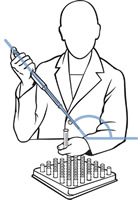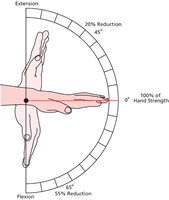Ergonomic injuries are widely recognized as a major factor in work place health. About one-third of all occupational injuries and illnesses stem from over exertion and/or repetitive motion.
Carpal Tunnel Syndrome (CTS), according to the U.S. Department of Labor Occupational Safety & Health Administration (OSHA), results in more days on average away from work than any other workplace injury. The median number of days away from work for CTS is 25 days, compared to 17 days for fractures, and 20 days for amputations. Workers with severe injuries can face permanent disability that prevents them from returning to their job or handling simple everyday tasks. The act of picking up a child, or even pushing a shopping cart, can become a painful experience.
The most common cause of Carpal Tunnel Syndrome is inflammation of the tendons in the carpal tunnel which can be attributed to repetitive use of the hand and/or wrist in awkward positions. Although there are no epidemiologic studies that identify the dose-response relationship of posture to risk, several studies have shown that wrist flexion/extension, ulnar/radial deviation and forearm supination/pronation does modify carpal tunnel pressure. Other studies have indicated that fluid pressures of 40-50mmhg sustained for 60 minutes can cause transient changes in nerve function while additional studies have indicated that elevated carpal tunnel pressure can cause more prolonged effects on tissue1. Although a critical pressure-time threshold associated with CTS has yet to be determined, the pressure is likely to be below the critical threshold apparent for acute median neuropathy, which is approximately 30mmHg2, 3. Clearly, in order to reduce the risk of CTS while pipetting, individuals should maintain neutral forearm and wrist positions that cause the least amount of pressure on the carpal tunnel while pipetting.
Contributing Factors:
Forearm supination and pronation
Effects of forearm pronation and supination on carpal tunnel pressure
Data comparing the use of different pipettes and the associated forearm rotation during pipetting
Wrist radial and ulnar deviation
Data comparing the use of different pipettes and the associated wrist
radial and ulnar deviation during pipetting
1. Rempel D, Bach, J, Gordon L, So, Y. Effects of Forearm Pronation/Supination on Carpal Tunnel Pressure. J. Hand Surg 1998; 1:38–42
2. Gelberman RH, Hergenroeder PT, Hargens AR, Lundborg GN, Akeson WH. A study of carpal canal pressures. J Bone Joint Surg 1981; 63A:380–383
3. Lundborg G, Gelberman RH, Minteer-Convery M, Lee YF, Hargens AR. Median nerve compressioin in the carpal tunnel: functional response to experimentally induced controlled pressure. J. Hand Surg 1982; 7:252–259
 What is forearm supination and pronation?
What is forearm supination and pronation?
Forearm supination is movement of the forearm causing the hand to be positioned in a “palm up” posture. Forearm pronation is movement of the forearm causing the hand to be positioned in a “palm down” posture. Forearm rotation during pipetting is common with axial designed pipettes. As illustrated, pipettes are often rotated, causing the hand to be positioned “palm up” (supination) and the wrist bent backwards. This is a common posture when attempting to maintain the elbow close to the body or rest it on the work surface. This is also a common posture that results when a user attempts to rotate the pipette out of their line of sight so they can accurately position a tip into a well on a microtiter plate.
Effects of forearm supination and pronation on carpal tunnel pressure
Repetitive twisting of the forearm between the palm up and palm down positions (supination and pronation of the forearm) throughout the pipetting task, as well as wrist flexion and extension increases the fluid pressure. A recent study measured the effects of forearm supination/pronation on carpal tunnel pressure found that carpal tunnel pressure was at its lowest when the forearm is maintained at 45° pronation. The extension/flexion and ulnar/radial deviation postures associated with the lowest carpal tunnel pressure cited a forearm rotation angle near 45° pronation. Although a critical pressure-time threshold associated with CTS has yet to be determined, the pressure is likely to be below the critical threshold apparent for acute median neuropathy, which is approximately 30mmHg.
The published article from the study appears in the Journal of Hand Surgery, Volume 23A – Number 1, further states “This set of postures should be considered during the design of hand-intensive tasks and hand tools in order to minimize carpal tunnel pressure during repetitive activities.”
 Is there data comparing the use of different pipettes and the associated forearm rotation during pipetting?
Is there data comparing the use of different pipettes and the associated forearm rotation during pipetting?
Ergonomic Technologies Corporation, an independent consulting firm specializing in workplace ergonomics, conducted a series of tests using traditional axial-designed pipettes and VistaLab Technologies’ new Ovation BioNatural Pipette. Electromyogram testing (EMG) was used to measure the activity of muscle groups and degrees of rotation during various pipetting tasks. (Electromyography (EMG) studies the function of individual nerves and muscles and includes measurement of nerve and muscle response to electrical stimulation and measurement of spontaneous muscle electrical activity) The testing revealed that the Ovation pipette showed a significant reduction in forearm rotation and wrist flexion during use when compared to other pipettes. The Ovation pipette’s shape and operating position reinforce ergonomically-correct pipetting by encouraging the user’s hand, wrist, and arm to assume the neutral postures near 45° pronation recommended by ergonomic experts.
 What is wrist flexion and extension?
What is wrist flexion and extension?
Wrist extension is the upward movement of the wrist to which results in the palm facing outward, while wrist flexion is the downward or inward movement of the wrist which results in the palm facing inward (see illustration below). Both movements reduce available strength, however flexion can cause up to 55% reduction in strength at just 25° of motion from a neutral position.
 Is there data comparing the use of different pipettes and the associated wrist flexion and extension during pipetting?
Is there data comparing the use of different pipettes and the associated wrist flexion and extension during pipetting?
Ergonomic Technologies Corporation, an independent consulting firm specializing in workplace ergonomics, conducted a series of tests using traditional axial-designed pipettes and VistaLab Technologies’ new Ovation BioNatural Pipette. Electromyogram testing (EMG) was used to measure wrist flexion and extension during pipetting. . (Electromyography (EMG) studies the function of individual nerves and muscles and includes measurement of nerve and muscle response to electrical stimulation and measurement of spontaneous muscle electrical activity) While average wrist extension was similar for all pipettes during an uninterrupted pipetting cycle, average wrist flexion when using axial-designed pipettes exceeded the recommended limits supported in published literature. This contributes to muscle fatigue which can lead to musculoskeletal injury.
 What is wrist radial and ulnar deviation?
What is wrist radial and ulnar deviation?
Radial and ulnar deviation is the side-to-side movement of the hand at the wrist, toward or away from the thumb. Radial deviation causes up to a 20% reduction in hand strength with just 25 ° of motion from a neutral position. At 40% Ulnar deviation a similar drop in available strength is observed (see illustration).
 Is there data comparing the use of different pipettes and the associated radial and ulnar deviation during pipetting?
Is there data comparing the use of different pipettes and the associated radial and ulnar deviation during pipetting?
Ergonomic Technologies Corporation, an independent consulting firm specializing in workplace ergonomics, conducted a series of tests using traditional axial-designed pipettes and VistaLab Technologies’ new Ovation BioNatural Pipette. Electromyogram testing (EMG) was used used to measure wrist radial and ulnar deviation during pipetting. . (Electromyography (EMG) studies the function of individual nerves and muscles and includes measurement of nerve and muscle response to electrical stimulation and measurement of spontaneous muscle electrical activity) While there was little difference observed in ulnar deviation among all pipettes, a significant difference in radial deviation was observed between the Ovation BioNatural Pipette and the traditional axial-designed pipettes. As noted earlier, increased radial deviation reduces hand strength and can result in fatigue.
